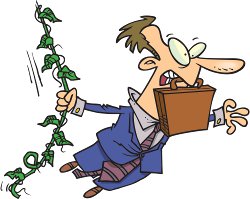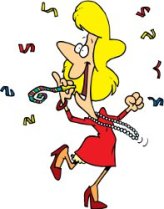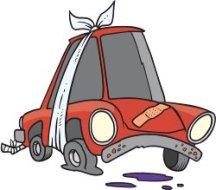The Hyphen
Rules and Examples
 A
hyphen is a short line ( - ) used in the English language to connect
the parts of a compound word or to connect split words such as numbers
(twenty-nine) and job titles (vice-president).
A
hyphen is a short line ( - ) used in the English language to connect
the parts of a compound word or to connect split words such as numbers
(twenty-nine) and job titles (vice-president).Click Here for Step-by-Step Rules, Stories and Exercises to Practice All English Tenses
A compound word is made by combining two separate words.
Depending on the dictionary, many of these words can be found written with a hyphen, as two separate words or as one complete word.
Example:
- book-keeper
- book keeper
- bookkeeper
The current trend in English writing is to get rid of unnecessary hyphens. Use a dictionary when in doubt. Click here for some good online dictionaries.
If you are still unsure on whether or not to use a hyphen with a compound word, it is best to leave the hyphen out.
 Here are a few common
compound words that do not require a hyphen:
Here are a few common
compound words that do not require a hyphen:- rainforest
- website
- baseball
- cannot
- headache
- laptop
- businessman
- schoolteacher
 Here are a few common
compound words that are usually written with a
hyphen:
Here are a few common
compound words that are usually written with a
hyphen:- truck-driver
- ice-cream
- year-end
- sign-in
- warm-up
- mother-in-law
- free-for-all
- follow-up
 These are a few common
compound words that are written with a space between
the words and no hyphen:
These are a few common
compound words that are written with a space between
the words and no hyphen:- voice mail
- help desk
- fact sheet
- school year
- time line
General uses of the hyphen
 1.
Use a hyphen to join two or more words that
stand for a
single adjective
(describing word) before a noun.
1.
Use a hyphen to join two or more words that
stand for a
single adjective
(describing word) before a noun.
Examples:- chocolate-covered donuts
- well-known doctor
- much-needed vacation
- nice-looking girl
 Do not
use a hyphen if the two words have separate meanings and do not
stand as a single adjective.
Do not
use a hyphen if the two words have separate meanings and do not
stand as a single adjective.Examples:
- friendly little girl
- beautiful red dress
- small round ball
2. Use a hyphen when spelling out numbers between 21 and 99.
Examples:- twenty-one
- thirty-three
- seventy-five
- ninety-nine
3. Use a hyphen when spelling out fractions.
Examples:- one-third
- two-fourths
- seven-eighths
4. Use a hyphen to avoid confusion in meaning.
 Examples:
Examples:a little-used car
(The hyphen is used to mean a car that is not used often.)
a little used-car
(The hyphen indicates that the used car is small.)
5. Use a hyphen with some job titles.
Examples:- vice-president
- attorney-general
- secretary-general
Using hyphens with prefixes
As I said above, the current trend in writing English is to get rid of
unnecessary hyphens. Therefore, most prefixes do not require a
hyphen. Follow the rules below when deciding whether to use a hyphen with a prefix. If you are still unsure and cannot find the word in a dictionary, it is best not to use a hyphen.
1. Hyphenate prefixes before proper nouns.
Examples:- un-American
- anti-Republican
- pre-Vietnam War
- mid-May
2. Use a hyphen with most words that begin with the prefix
self-. (Do
not use a hyphen with the words "selfless" and "selfish.")
Examples:- self-control
- self-respect
- self-check
3. Use a hyphen with words that begin with the prefix ex-.
Examples:- ex-wife
- ex-military
- ex-student
4. Use a hyphen with most words that begin with the prefix
non-.
(Do
not use a hyphen with "nonaligned," "nonconformist" or "nonstop.")
Examples:- non-smoker
- non-alcoholic
- non-violent
5. Use a hyphen when the prefix ends in the same letter the
word begins.
Examples:- semi-invalid
- inter-related
6. Use a hyphen with the prefix re- when it stands
for
"again" and there is confusion with another word.
Example:I will recover from my illness.
(We do not use a hyphen because re- does not mean again. The word recover means to get better.)
I am going to re-cover the sofa.
(Use a hyphen because re-cover means to cover again.)
Using hyphens to break lines
When reading books you may sometimes notice the hyphen at the end of a line.The hyphen is there because there wasn't enough space in that line for the entire word.
The solution was to divide that word between that line and the next one. The hyphen is there to show us that this is actually a single word that continues on the next line.
For example:
- Joe worked in the company for many years. Finally, He made
a deci-
sion to quit this job and find a new one.

These were the uses of the hyphen. Now that you know them, it is time to practice! Read and do exercises.
Get Updates, Special Offers, and English Resources
Download your FREE GIFT (the first two chapters of
English Short Stories Book and Workbook)
as soon as you join!

By submitting your email, you consent to receiving updates and newsletters from us and to the sharing of your personal data with third parties for the purposes of sending you communications. We will not spam you. You can unsubscribe at any time. For more information, please see our privacy policy.





